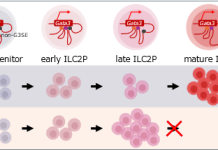This post is in partnership with Hello, Peanut!
 Helping our babies explore new foods is a joy and milestone as mothers. Whether baby’s next meal is from the farmer’s market stall or off the shelf, we all do the best we can to keep baby happy, healthy, and fed. Besides introducing a variety of flavors, textures, and nutrients, don’t forget to proactively incorporate peanut into your baby’s diet once they’re successfully eating solids.
Helping our babies explore new foods is a joy and milestone as mothers. Whether baby’s next meal is from the farmer’s market stall or off the shelf, we all do the best we can to keep baby happy, healthy, and fed. Besides introducing a variety of flavors, textures, and nutrients, don’t forget to proactively incorporate peanut into your baby’s diet once they’re successfully eating solids.
As a food allergy mama, I urge you to plan ahead before introducing your child to a potential food allergen. With my second child, we used Hello, Peanut! to gradually and safely introduce peanuts.
Here’s what you need to know about introducing peanut to your baby.
Earlier is better
This is one of those things that your well intending mother or mother-in-law might not be up to date on. The latest research shows earlier is better for peanut introduction. Once your baby can consume solids successfully, s/he may be ready to try peanuts! Consult your doctor before proceeding to Go.
Be aware of your baby’s risk
The presence of eczema and/or an egg allergy indicates a higher risk for a peanut allergy. According to my son’s allergist, having another child with food allergies is not believed to be a risk factor. She cited a study where siblings of children with food allergies only had a slightly higher rate of also having food allergies. The allergist surmised that the increased number of food allergy cases in siblings might be due to parents delaying introduction of food allergens out of fear.
If your baby has a high risk of having a peanut allergy, your doctor may advise testing and/or office assistance with peanut introduction. Please be aware that for skin and oral food allergy testing, your baby should not have any cold symptoms that might make a test difficult to interpret. Because my daughter was not deemed high risk, our allergist did not advise precautionary testing due to the possibility of false positive test results.
Do it gradually and carefully
Our allergist advised us to first apply peanut product to our daughter’s lips, and then wait and observe for 10 minutes before proceeding to the first small taste. Then after another 10 minutes of observation, baby could eat at baby’s pace. She told us to have an adult available to observe our baby for 2 hours after finishing her peanut product.
We used Hello, Peanut!, created by an allergist, to easily and safely introduce peanuts gradually. Their Introduction Kit includes individually wrapped packets of organic peanut flour and oat flakes. The contents are mixed into food your baby has already eaten successfully. (Please be aware that standalone peanut butter is a choking hazard for babies!) Hello Peanut! packets specifically contain 3 grams of peanut protein modeled after the Leap and Eat study that first found early introduction is better. Other allergy introduction products include a mix of top allergens, but this would make it difficult to isolate the cause of a reaction. (Also be aware that the Leap and Eat study specifically researched peanut introduction and not other top allergens.
It’s not one and done
Once you’ve introduced peanuts, you’re not done! Even if it’s not a part of your standard diet, you will need to continue exposing your baby to peanuts. Our allergist estimated my daughter should eat peanut 2–3 times a week. After the week of daily Hello, Peanut! introductory packets, my daughter graduated to Hello, Peanut! maintenance packets (containing the 1 gram of peanut) to be consumed up to 3 times a week.
Be prepared
We were advised to introduce peanut at home with allergy medication and dosage information available. Our allergist advised that over the counter liquid Zyrtec should suffice, though we also had my son’s Jr. EpiPens available. For families with older siblings, we arranged for our son to be out of the house with a babysitter. This way we could head to the hospital if needed without having to worry about additional childcare logistics. Also, because of our son’s allergies, we didn’t want to traumatize him as a witness to an allergic reaction. If your baby reacts to the peanut product, contact your medical professional for next steps.
Fellow peanut allergy families will have to plan ahead for how you can introduce peanut safely. This was the first time in years that we had a peanut product consumed in the house. One friend shared that she has separate dishes and sponges for her baby to consume peanut. I’ve heard some families have everything available and introduce food out of the home away from allergic children or near the hospital for extra measure. It might be frowned upon from a waste perspective, but I resorted to having disposable cups and spoons for easier clean up at home, although I still need to carefully clean my daughter’s body, high chair, clothes, and bibs.
You’re doing the best you can
My daughter was still drooling out solids at 7 months, so her doctor said I had to practice solids more before peanut introduction. It was stressing me out because I would meet parents who had given peanut as early as 4 months!
Early introduction does not guarantee peanut allergy prevention. Your child may have a reaction at first exposure, or sometimes allergies develop later in life. In my case, I felt guilty for so long about my son’s peanut allergy, but it’s impossible to know exactly how food allergies develop. Wherever you are in your journey, remember to tell yourself that you’re doing the best you can. Then, breathe and repeat.
Did you know?
Hello, Peanut!’s petition was solely responsible for the FDA clearing the health claim linking early peanut introduction and peanut allergy prevention. Thank you Hello, Peanut! for playing an integral role in the health of my daughter and other children!
Editor’s note: Always consult with your family’s pediatrician/medical team on the appropriate feeding protocol for your child.




















